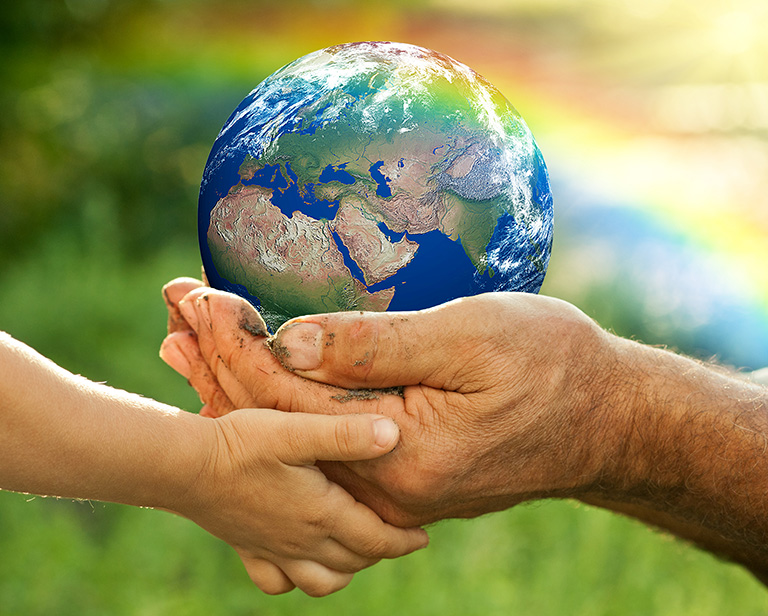Happy Earth Day
We have hundreds of red tulips coming up around the buildings!
Today marks the anniversary of the birth of the modern environmental movement known as Earth Day. At KHT, we’re proud of our environmental record and actions we take every day to respect and protect our environment. Like most, we are constantly learning, not only what we can do as a company, but every day as individuals. Here’s some history on this incredible movement, started by an individual with a concern. It’s a bit long for my post, but a great read. Enjoy, and be sure to stop by the plant to see our early spring plantings and winter clean up.
Setting the Stage
The height of counterculture in the United States, 1970 brought the death of Jimi Hendrix, the last Beatles album, and Simon & Garfunkel’s “Bridge Over Troubled Water.” War raged in Vietnam and students nationwide overwhelmingly opposed it. At the time, Americans were slurping leaded gas through massive V8 sedans. Industry belched out smoke and sludge with little fear of legal consequences or bad press. Air pollution was commonly accepted as the smell of prosperity. “Environment” was a word that appeared more often in spelling bees than on the evening news. Although mainstream America largely remained oblivious to environmental concerns, a watershed moment emerged with the heightened awareness of the 1962 book Silent Spring, raising public awareness and concern for living organisms, the environment and links between pollution and public health.
The Idea
The idea for a national day to focus on the environment came to Earth Day founder Gaylord Nelson, then a U.S. Senator from Wisconsin, after witnessing the ravages of the 1969 massive oil spill in Santa Barbara, California. Inspired by the student anti-war movement, he realized that if he could infuse that energy with an emerging public consciousness about air and water pollution, it would force environmental protection onto the national political agenda. Senator Nelson announced the idea for a “national teach-in on the environment” to the national media; persuaded Pete McCloskey, a conservation-minded Republican Congressman, to serve as his co-chair; and recruited Denis Hayes from Harvard as national coordinator. Hayes built a national staff of 85 to promote events across the land. April 22, falling between Spring Break and Final Exams, was selected as the date.
When it all Began
On April 22,1970, 20 million Americans took to the streets, parks, and auditoriums to demonstrate for a healthy, sustainable environment in massive coast-to-coast rallies. Thousands of colleges and universities organized protests against the deterioration of the environment. Groups that had been fighting against oil spills, polluting factories and power plants, raw sewage, toxic dumps, pesticides, freeways, the loss of wilderness, and the extinction of wildlife suddenly realized they shared common values. Earth Day 1970 achieved a rare political alignment, enlisting support from Republicans and Democrats, rich and poor, city slickers and farmers, tycoons and labor leaders. By the end of that year, the first Earth Day had led to the creation of the United States Environmental Protection Agency and the passage of the Clean Air, Clean Water, and Endangered Species Acts. “It was a gamble,” Gaylord recalled, “but it worked.”
Going Global
By 1990, the Earth Day celebration had gone global, mobilizing over 200 million people in nearly 150 countries and lifting environmental issues onto the world stage. Earth Day 1990 gave a huge boost to recycling efforts worldwide and helped pave the way for the 1992 United Nations Earth Summit in Rio de Janeiro. It also prompted President Bill Clinton to award Senator Nelson the Presidential Medal of Freedom (1995)—the highest honor given to civilians in the United States—for his role as Earth Day founder. By 2010, Earth Day 2010 came at a time of great challenge for the environmental community. Climate change deniers, well-funded oil lobbyists, reticent politicians, a disinterested public, and a divided environmental community all contributed to the narrative—cynicism versus activism. Despite these challenges, Earth Day prevailed and grew to include a 250,000-person National Mall rally and the “Billion Acres of Green” global tree planting initiative (now called the Canopy Project), connecting 22,000 partner organizations in 192 countries.
Earth Day Today
Earth Day has reached its current status as the largest secular observance in the world, celebrated by more than a billion people every year, and a day of action that changes human behavior and provokes policy changes. Much like the early days, the fight for a clean environment continues with increasing urgency, as the ravages of climate change become more manifest every day. Strong voices shout on both sides as to what we should, or should not do next. It’s up to each of us to decide what’s right and act.
Special thanks to earthday.org for much of this content. To learn more, visit http://www.earthday.org/about/the-history-of-earth-day/#sthash.K2XJxoG3.dpuf




